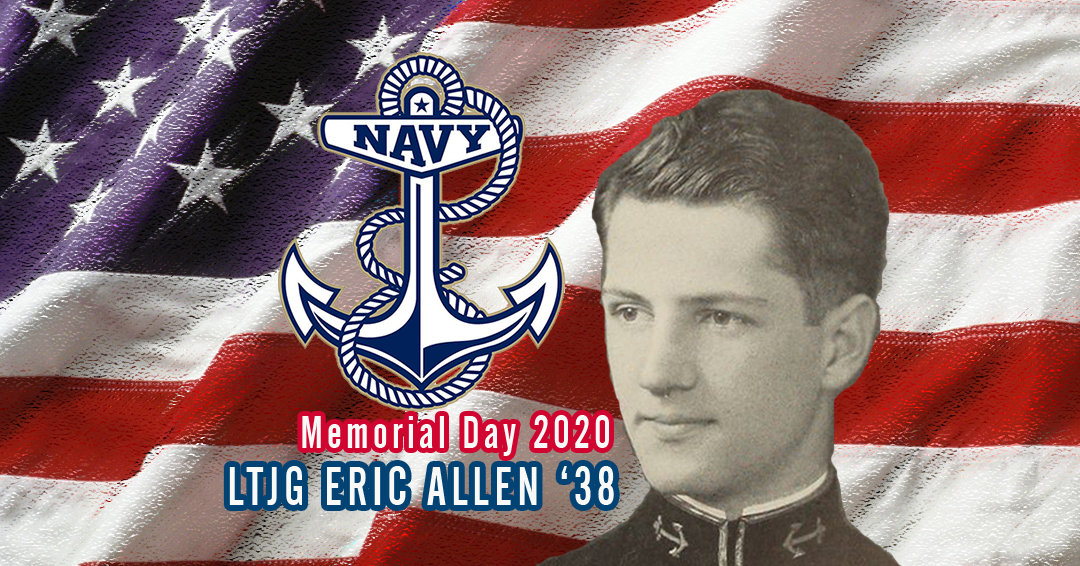BRIDGEPORT, Pa. — The history of the Collegiate Water Polo Association (CWPA) is marked with athletes who volunteered for military service, including those the league and the nation remembers on Memorial Day.
Prior to the formation of the league in the early 1990’s, the legacy of sacrifice by water polo athletes dates back to the turn of the century as outstanding men and women answered the call and took to the land, sea and air in defense of their nation.
In celebration of their service and memory of their sacrifice, the league recalls the life of United States Naval Academy alum LTJG Eric Allen ’38 who was among the first American losses in the Pacific theater during World War II.
Born in Manchester, Vt., and the son of Rev. Eric Allen, Sr., he was headed to a live of ministry in Connecticut prior to enrolling in the Naval Academy. A member of the water polo team at Navy during his sophomore, junior and senior years, he was a four-year member of the Glee Club at the Academy and was part of the musical club as a freshman, sophomore and senior.
Upon his graduation from Annapolis, he joined the light cruiser U.S.S. Trenton as an ensign in July 1938 and remained on the ship until receiving orders for flight training at Pensacola, Fla., in August 1940. Designated a Naval Aviator in January 1941, he was promoted to a Lieutenant Junior Grade in 1941 and was attached to VF-6/Fighting Squadron 6 flying the F4F Wildcat off the U.S.S. Enterprise (CV-6). VF-6 was also the squadron of fellow Navy water polo athlete Butch O’Hare, the namesake of Chicago’s O’Hare International Airport, who was lost later in the war.
Allen’s life would come to an end with the start of the United States’ involvement in World War II at Pearl Harbor.
Due to the Enterprise being at sea during the attack, preventing the decimation of the American’s ability to respond to Japan’s navy in the following months, Allen was not in the air at the time of the attack.
Following word of the attack reaching the Enterprise, commanding officer William “Bull” Halsey dispatched a force of six Wildcats which escorted a strike force consisting of 18 TBD Devastator torpedo aircraft and six Dauntless dive-bombers fitted with smoke generators to mask the TBDs as they approached their targets. Their mission was to locate Japanese aircraft carriers that had launched the attack on Pearl and engage them.
Unable to locate the Japanese, torpedo and dive-bombers were ordered back to the Enterprise, while Allen and the five other Wildcats were directed to continue on to Pearl Harbor and render any assistance as necessary.
As the six Wildcats approached Hickam Field near Pearl Harbor their arrival triggered a panic, even though the message of their arrival was repeatedly broadcast, and they were fired upon by ground American anti-aircraft fire.
Ensign Herbert H. Menges immediately fell victim to the anti-aircraft fire and crashed to become the first Navy fighter pilot to die during World War II. LTJG France F. Hebel’s fighter was shot down next and crashed near Wheeler Field. He suffered a skull fracture during the crash and died.
Ensign James Daniels was the only one of the six airmen to land on an airfield as he set down at Ford Island Naval Air Station. Daniels is notable as he became the lone American pilot to be at the attack on Pearl Harbor and survive to witness the Japanese surrender in 1945.
Similar to Daniels, fellow Ensign’s Gayle Hermann and David Flynn also survived as Hermann landed on a golf course on Ford Island, while Flynn’s plane ran out of fuel and he parachuted into a sugar cane field.
Allen did not fare as well as he was hit by a round while still in his aircraft and bailed out at a low altitude over Pearl Harbor. On his descent, he was hit by a .50 caliber shell with his parachute only partially opening leading to severe internal injuries upon impact with the water. Although shot and injured, he landed in the oily water near the mindsweeper U.S.S. Vireo and swam to the ship. He later succumbed to his injuries the following day on December 8.
He was originally interred in the Halawa Naval Cemetery, Oahu, Hawaii, and was later re-interred at the National Memorial Cemetery of the Pacific in Honolulu on January 26, 1949.




